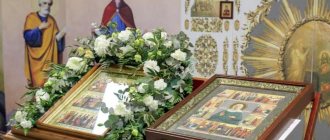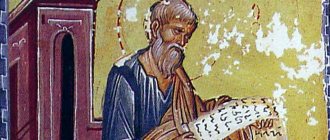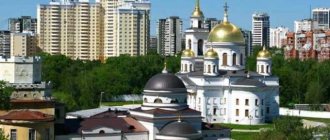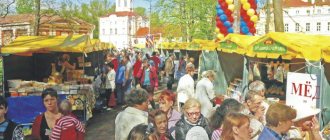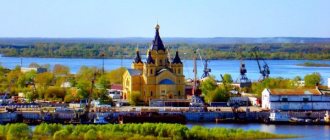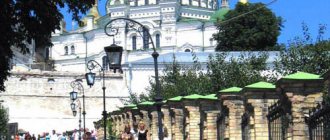An unusual exhibition of icons opened at the Alexander Nevsky Lavra
It is noteworthy that the exhibition is presented in the premises of the Alexander Nevsky Church of the monastery, which was only recently transferred to the monastery.
“It was into this temple that Peter I brought in his hands the relics of the holy prince, which were transported from Vladimir, where they were originally kept,” emphasized Dmitry Mironenko, head of the Lavra’s icon-painting workshop. — Initially, we wanted the exhibition to be in a large state museum, but it didn’t work out. That's why we arranged it at our place. Many churches in the diocese responded to the call to donate icons for the duration of the exhibition. We managed to collect icons from different times of creation and writing styles,” Mironenko explained.
For example, on the most ancient icons Alexander Nevsky is depicted not in princely clothes, not in knightly armor, but as schemamonks. Let me remind you that before the death of his missus, the prince accepted the schema, and this is precisely what is reflected in more ancient images. But most of the icons on display date back to the 19th century. All icons are prayed for. They came to them with prayers, but they approached them with tears of joy - that what they asked for had been fulfilled. The exhibition will be of interest not only to believers. The exhibition represents a whole historical layer associated with the name of Alexander Nevsky.
— Alexander Nevsky is such a multifaceted personality that absolutely everyone will find in her what they need. Especially the younger generation, which is looking for heroes somewhere far away, but knows little of its own - Russian ones, - said the vicar of the Lavra, Bishop Nazariy of Kronstadt. By the way, there are Arab chronicles that describe the prince’s arrival in the Golden Horde. And there the women, seeing the beauty and strength of Alexander Nevsky, brought their children to him, so that this strength and beauty would pass on to them.
For the 800th anniversary of Alexander Nevsky, a unique encyclopedia “In the Name of the Holy Prince” was prepared and published, the author and compiler of which is Bishop Nazariy. The three-volume book is dedicated to churches, chapels and other places of prayer associated with Alexander Nevsky. Vladyka personally traveled to various regions for several years and collected information.
— Do you know what the strongest impressions from trips are? The tragedy of disappearance, which I saw in some Russian and Ukrainian villages. Temples represent it. Why? They were built extensively, and if the entire village is in ruins, the church is in ruins. Instead of a good road that once led to the temple, there is a windfall. And from a number of temples, only a few stones remained,” the bishop recalls.
The exhibition at the Lavra will last until July 13. Admission to it is free.
Photo: Alexander Nevsky Lavra
Icon of the Mother of God “Quick to Hear” Nevskaya
Voice 8
Song 1
Irmos: Having passed through water like dry land, and having escaped the evil of Egypt, the Israeli cried out: Let us drink to our Deliverer and our God.
Taking many blessings to praise Your Divine miracles, I pray to You, O Virgin, from the heart, to the Quick to Hear, grant me grace.
Who will not be amazed at Your miraculous image, O Virgin? From him, you cried out to the server of the meal three times, having been called Quick to Hear.
What miracles of Thy can I perform, O Young Lady? You made the disobedient monk blind before, and again you made this, seeing.
Rejoice, sacred monastery of Dochiar: you are the Lord of the Representative of all and the cover, as She herself clearly erected.
Song 3
Irmos: O Supreme Creator of the heavenly circle, O Lord, and the Creator of the Church, Thou strengthenest me in Thy love, the desires of the land, the faithful affirmation, the One Lover of Mankind.
You, Mary, showed the childless, blessed ones, and you made barren wives, Quick to Hear, rejoicing over their children. Who will not be amazed, O Virgin, at Your greatness?
Bulgaria preaches miracles in Your image, O Quick to Hear, East and West. You have become a fountain, flowing grace to all who call on Your name.
The disease of cancer disappears by hand from the hand of an honest woman, O Virgin, by Thy visitation, the same sufferer, freed from the disease, rejoicing, a sermon of thanksgiving.
Wonderfully adorned is Your icon, Quick to Hear, and illuminates everyone with Your grace, O Most Pure One, more than the rays of the sun. Who will not praise You, glorified in Heaven and on earth!
Sedalen
We know You, the Lady of the world, Mary, the All-Singing One, for You have given birth to us all, the Creator, the Savior of the world, who also glorified You, Your Most Pure Mother, giving You grace and mercy to those who honor You and pray to You, Theotokos.
Song 4
Irmos: I heard, O Lord, Thy mystery, I understood Thy works and glorified Thy Divinity.
Your miraculous image has been glorified in all corners, and now with all their lips they pronounce the Word of the Quick to Hear.
And in a dream, the All-Tsarina, and in reality, the Quick to Hear, appearing and performing miracles in the world, glorious.
Who is your name, O Virgin, that you call upon in every need, and yet you did not hear it, like a being quick to hear?
Blessed are you, the glorious monastery of Dochiar, for you have enriched yourself with the icon of the all-honorable Quick-to-Hear.
Song 5
Irmos: Enlighten us with Your commandments, O Lord, and with Your high arm grant us Your peace, O Lover of Mankind.
How I, unworthy, will look at Your most pure image, Quick to Hear, with my unclean hairs!
Sea and land, O All-Tsarina, Your icons preach miracles: For these two have enjoyed Your graces.
Tatya, you appear, having stolen the penalty from your neighbor, Materodevo, and return this righteousness to the one who has it.
What shall we render unto Thee, O All-Blessed One, for the great grace which Thou hast shown us, by bestowing Thy icon, sacred wealth.
Song 6
Irmos: I will pour out a prayer to the Lord and to Him I will proclaim my sorrows, for my soul is filled with evil and my stomach is approaching hell, and I pray like Jonah: from aphids, O God, lift me up.
As if the loving Mother had appeared, You called the boy to Yourself, until You delivered You from the hand of robbers, Materodevo. But may we also find You, the loving Mother!
Thy servants have no other imams than You, intercession and protection. Moreover, O Pure One, we cry from the heart: free Your flock and the faithful who come running to You from all troubles.
Just as You saved those who called on Your Divine name from the storm of the sea, so too from sensual and mental collapse, Virgin, save us and guide us into the quiet haven of salvation.
The world of Thee is the refuge of the acquisitive and salvation; Therefore, O Pure One, people flock from everywhere to Your most honest icon, and all of them will soon find You listening to them.
Kontakion, tone 8
In the midst of everyday life we are overwhelmed, we fall into the anxiety of passions and temptations. Give us, O Lady, a helping hand, like Thy Son Peter, and speed up the deliverance of us from troubles, so that we call Thee: Rejoice, All-Good One, Quick to Hear.
Ikos
Where Your grace overshadows, O Lady, there the sick are restored to health, the afflicted come to prosperity, and everyone who mourns is filled with joy. By the same grace of Thy autumn we also, the joyful blue chick, say unto Thee: Rejoice, O God-gracious, village of the Unapproachable Divinity; Rejoice, holy table, who supplies us with the bread of life; Rejoice, precious myrrh, fragrant to the faithful; Rejoice, olive tree, anointing us with the oil of mercy; Rejoice, inexhaustible treasure of gifts; Rejoice, ever-flowing source of miracles; Rejoice, intercession of the offended; Rejoice, you who are overwhelmed by a pleasant haven; Rejoice, hearing for the deaf and light for the blind; Rejoice, strengthening of the weakened; Rejoice, liberation of the captives; Rejoice, hope of all peace; Rejoice, All-merciful Quick Hearer.
Song 7
Irmos: Having come from Judea, the youths in Babylon sometimes, by the Trinity’s faith, asked the flames of the cave, singing: God of the fathers, blessed art thou.
Thou hast granted to the blind the power of combing, O Virgin, to see, but also to enlighten the apple of our soul and body, that we may ever sing of Thy greatness.
You have granted hearing to the deaf, Mary the Quick to Hear, but also open us all to the ears of soul and body, so that we may ever sing of Your greatness.
Just as in ancient times you delivered those who came running to You from harm, O Most Pure One, so deliver us from this and all harm, so that we may always sing of Your greatness.
Just as you corrected the weakened one before, so correct us, both weakened, through your warm intercession, so that we may ever sing of your greatness.
Song 8
Irmos: Praise and extol the Heavenly King, Whom all the Angels sing, praise and extol forever.
From all diseases, O Quick Hearer, deliver us, just as you have delivered us from these many.
Your icon, O Virgin, has appeared as a source of miracles, from which those who thirst are abundantly supplied.
You reveal the lost, O Lady, and give joy to those who have found them. How many are the graces of Your image!
All the elements obey Your command, O Lady, and deliver those who call upon You from harm.
Song 9
Irmos: Truly we confess Thee, Theotokos, saved by Thee, Pure Virgin, with the Bodiless faces magnifying Thee.
Gather diligently to the Divine Abode of the Archangels, those who are sick: for the Physician dwells in it free of charge.
Another sacred icon of Yours appeared, the Pool of Siloam, the Virgin, cleansing and healing illnesses of the soul and body.
The zeal to see Your image ignites the grace-filled beauty, and the imam does not exalt You!
May I see You, O All-Blessed Quick Hearer, who consoles me at the time of death and drives away the ghosts of demons!
Svetilen
Those who behold You now on the icon with the Eternal Child, we ask You, Bride of God: do not deprive us in the future of the all-blessed sight of You and the Son of God incarnate from You, so that together with those who have pleased Him, we may magnify His Name and Yours.
Building complex
The architectural ensemble of the monastery was created in the 17th-18th centuries. It is characterized by features of Baroque and Classical styles. Design and construction were carried out with the participation of famous architects - D. Terzini, I. Starov, T. Schwertfeger, M. D. Rastorgueva. Residential and service buildings form a square around the courtyard. Each building has its own name, indicating its purpose - Metropolitan, Spiritual, Seminary, Sacristy, Library. There are towers in the corners. There are 15 churches on the territory of the monastery. On the bank of the Monastyrka River (formerly the Black River) a 2-story Annunciation Church (1724) was erected. It has a rectangular shape.
The top is crowned with an 8-sided dome. This is one of the oldest churches in the city built of stone. The interior is decorated with modeling (Rossi brothers), wall paintings (I. Nikitin, I. Vishnyakov), icons (G. Gzel). The crypt contains the tombs of many prominent people. Above the entrance to the monastery there is the Gate Church of Sorrow (The Joy of the Mother of All Who Sorrow). It was intended for artisans and traders serving the needs of the monastery. The attic position determined the modest size of the temple.
How to get there
In the St. Petersburg metro there is a station “Alexander Nevsky Square”. You need to get there. The station has 2 exits (1) and (2) , but there is no big difference depending on which one you choose.
In front of you will be the round Alexander Nevsky Square, on which a monument to this saint is erected. We reach the Holy Gate (3), where the gate church and chapel in the name of the icon “Joy of All Who Sorrow” are located. We enter this gate and walk along the cobblestone embankment of the Monastyrka River (between two Necropolises) to the Annunciation Gate (4), entering which we find ourselves on the territory of the monastery.
Under No. (5) on the map I marked the location of its main Holy Trinity Cathedral.
Schedule of services
Access for parishioners and tourists is open to the Lavra every day from 5.30 to 23. Divine services in the Holy Trinity Cathedral are held according to the established schedule:
- prayer service at 6 a.m. (Monday-Saturday)
- Midnight Office at 6.20 a.m. morning (Monday - Saturday)
- early liturgy at 7 a.m. (Sunday)
- late liturgy at 10 a.m. (Saturday – Sunday and church holidays)
- evening at 5 pm (Monday-Sunday)
In the Church of Theodore of Novgorod, late liturgy is celebrated at 10 a.m. (Monday-Friday) and evening service at 5 p.m. (Sunday-Thursday). The service (liturgy) in the Gate Church takes place at 7 o'clock. mornings from Monday to Saturday.
Holy Trinity Cathedral
The core of the monastery complex is the Holy Trinity Cathedral. The building was constructed at the end of the 18th century. It has the features of a classical architectural style. The central façade looks like a portico with 6 columns. The upper part is made in the shape of a triangle. The exterior decoration of the building consists of sculptures illustrating passages from the Old and New Testaments. They were made according to the sketches of the famous Russian architect F. Shubin.
The interior of the cathedral has a 3-nave division. The walls around the iconostasis are covered with marble. The altar screen is made of bronze casting with an elegant pattern. The vaults and dome were painted according to sketches by D. Quarenghi. The temple is adjacent to 2 bell towers with a height of 47 m. Bells are installed on them, incl. “Blagovestnik” (weight – 18 tons).
Cossack cemetery
On the territory of the Lavra in the 18th – 20th centuries. Several burial places were set up. Monks, clergy, and townspeople were buried in the cemeteries inside the monastery. The most famous monastic necropolis is the Internal Alexander-Nevskoye Cemetery. It is also called Cossack. In memory of the Cossacks who died during the dispersal of the Bolshevik demonstration in July 1917. Historical documents record the official opening date of the necropolis - December 1919.
During the years of Soviet power, the name Communist Site was assigned to the place. The place was reserved for the burial of participants in the civil war, party functionaries, employees of internal affairs bodies and the Cheka. Since the 1930s, graves of famous scientists began to appear on the Site (N. Marr, B. Legrand, M. Basov, I. Grekov, S. Fedorov, etc.). The number of burials increased during the siege. Many prominent military leaders and heroes of the Great Patriotic War found their final refuge on the territory of the cemetery. Since the 70s In the necropolis, only the burial of urns with ashes after cremation is allowed.
Small architectural forms (tombstones, steles, sarcophagi, obelisks, etc.), widely represented in the cemetery, have artistic and aesthetic significance. In addition to secular ones, the necropolis contains the graves of ministers of the Orthodox faith. As a rule, they are marked with crosses. In 2005, a monument called “The Triumph of Orthodoxy” was erected on the territory of the Cossack cemetery. It glorifies the memory of people who died during the years of repression and anti-religious struggle. The monument was made according to the design of E. Solovyova. The overall plan includes almost 450 graves. According to historians, over 700 people were buried at the Cossack Cemetery during its existence.
Literature
- Brief description of the Bargrad St. Nicholas Church in Petrograd. Pg, 1916.
- A.N.V. Ea:38, case No. 51 for 1861.
- Memoirs of Archimandrite Afanasy (Nechaev). Old Valaam. North, 1991, No. 9
- Dmitrievsky A. A., Yushmanov V. D. Holy Rus' and Italy at the myrrh-streaming tomb of St. Nicholas of Myra in Bargrad. Pp, 1915.
- TsGAK f.762, op.1, d.213, l.9
- Consecration of the Bargrad St. Nicholas Church in Petrograd. Pg., 1917.
- Hieromonk Afanasy. The Legend of the Alexander-Nicholas Chapel: A note about the chapel being built in St. Petersburg on Peski. St. Petersburg, 1879.
- Central State Administration of the RSFSR, NKYu Foundation, “The Case of M. Veniamin.”
- “Biography of St. Benjamin, Metropolitan of Petrograd and Gdov (1873-1922).
- Synodik of the persecuted, martyred, and innocently injured Orthodox clergy and laity of the St. Petersburg diocese: 20th century. SPb., 1999].
- Shamonina. M. Petersburg Father. Life, ministry, work of Archpriest Vladimir. "Father's House", 1997.
- Schultz S. Temples of St. Petersburg. "Glagol", St. Petersburg, 1994.
- N.Yu. Cherepenina, M.V. Shkarovsky. “The St. Petersburg diocese in the twentieth century. 1917-1941” Faces of Russia. St. Petersburg 2000.
- Photo materials of TsGAKFFD.SPb.


